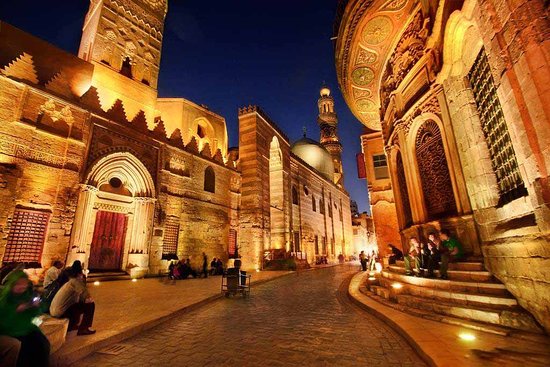
Exploring the Rich Heritage of Al Moez Ldin Allah Al Fatmi in Islamic Cairo
Islamic Cairo , with its enchanting historical landmarks, holds a treasure trove of cultural and architectural marvels. Among these, Al Moez Ldin Allah Al Fatmi stands tall as a testament to the city’s glorious past. This blog post takes you on a captivating journey to explore the rich heritage of Al Moez Ldin Allah Al Fatmi, shedding light on its significance and historical importance.
1- Historical Significance
Al Moez Ldin Allah Al Fatmi, often referred to as Al Moez Street, is a bustling thoroughfare that stretches through Old Cairo. It holds immense historical significance, as it was founded during the Fatimid era in the 10th century. One of the most important places in Egyptian Islamic history, Al Moez Ldin Allah Al Fatmi it runs along the central core of Islamic Cairo from Bab Al-Futuh to Bab Zuweila. This section delves into the historical context, highlighting the role it played in shaping the city’s cultural and architectural landscape.
2- Architectural Marvels
Walking along Al Moez Street is like stepping into a living museum of Islamic architecture. This section showcases the architectural marvels that adorn the street, including stunning mosques, palaces, and mausoleums. From the majestic Al-Hakim Mosque to the mesmerizing Sultan Qalawun Complex, each structure reflects the exquisite craftsmanship and artistic prowess of its time.
3- Vibrant Street Life
Al Moez Street is not merely a collection of ancient buildings; it is a vibrant hub of activity that offers a glimpse into the daily lives of Cairo’s inhabitants. This section explores the bustling street life, from the vibrant markets and traditional workshops to the aroma of local delicacies that waft through the air. Visitors can immerse themselves in the authentic atmosphere, engaging with artisans and savoring the vibrant energy of the street.
4-The Soul of Islamic Culture
Al Moez Ldin Allah Al Fatmi not only showcases architectural brilliance but also serves as a living heritage of Islamic culture. The street is lined with vibrant bazaars, where you can immerse yourself in the sights, sounds, and scents of a bygone era. From traditional crafts and textiles to aromatic spices and delectable street food, the essence of Islamic culture is palpable at every turn.
*Hidden Gems and Cultural Delights
Beyond the remarkable architecture, Al Moez Ldin Allah Al Fatmi offers a plethora of hidden gems and cultural delights. Explore the bustling Khan El Khalili market, where you can immerse yourself in the vibrant colors and aromas of spices, textiles, and traditional crafts. Visit the Sabil-Kuttab of Katkhuda, an architectural marvel that served as a public water fountain and Quranic school. Delve into the captivating history of the Beit El Sehemy house, a beautifully preserved mansion that offers a glimpse into the lifestyle of the elite during the Ottoman era.
1-Sultan Al Mansur Qalawun Mosque:
The Sultan Al Mansur Qalawun Mosque, located in the heart of Moez Ldin Allah Al Fatmi in Old Cairo, stands as a testament to the rich history and architectural brilliance of the Islamic world. The Sultan Al Mansur Qalawun Mosque was commissioned by Sultan Al-Mansur Qalawun, a prominent Mamluk ruler of Egypt, in the 13th century. Construction began in 1284 and was completed in 1285. The mosque was built to commemorate Sultan Qalawun’s victory over the Mongol invasion, symbolizing the resilience and strength of the Islamic empire during that era. Throughout the centuries, the mosque has witnessed various historical events and has remained a revered landmark in Cairo.
2- Beit El Sehemy house
The Beit El Sehemy house, built in the late 18th century, was originally constructed as the residence of the affluent El Sehemy family. Its history intertwines with the political and social transformations that Egypt witnessed over the years. From its inception as a private dwelling to its later use as a government office, this architectural masterpiece has witnessed the ebb and flow of time. you’ll be mesmerized by the intricate architectural details that adorn every corner. The house boasts a harmonious blend of Ottoman, Mamluk, and European influences, creating a unique fusion of styles. From intricately carved wooden mashrabiyas to vibrant tiles adorning the walls, each element tells a story of craftsmanship and artistic excellence.
3- The Al-Hakim Mosque
The Al-Hakim Mosque, also known as the Mosque of Al-Hakim bi-Amr Allah, was commissioned by the Fatimid Caliph Al-Hakim in the 11th century. It was built on the site believed to be the location where the 6th-century Church of Saint John the Baptist once stood. The mosque has witnessed numerous historical events, surviving wars, renovations, and even periods of neglect. Today, it stands as a symbol of resilience and cultural heritage.
5- Cultural Heritage Preservation
Preserving the cultural heritage of Al Moez Ldin Allah Al Fatmi is of utmost importance. This section sheds light on the efforts undertaken by local authorities, organizations, and communities to safeguard and restore the historical treasures along the street. It highlights the significance of sustainable tourism and the role visitors play in supporting these preservation initiatives.
Al Moez Ldin Allah Al Fatmi is more than just a street; it’s a living testament to the rich history, architectural brilliance, and cultural heritage of islamic Cairo. As you explore its winding paths and marvel at its grand structures, you can’t help but feel a sense of awe and admiration for the generations that came before us. So, whether you are a history enthusiast, an architecture lover, or simply someone in search of an enriching experience, Al Moez Ldin Allah Al Fatmi should be at the top of your must-visit list when in Old Cairo.

